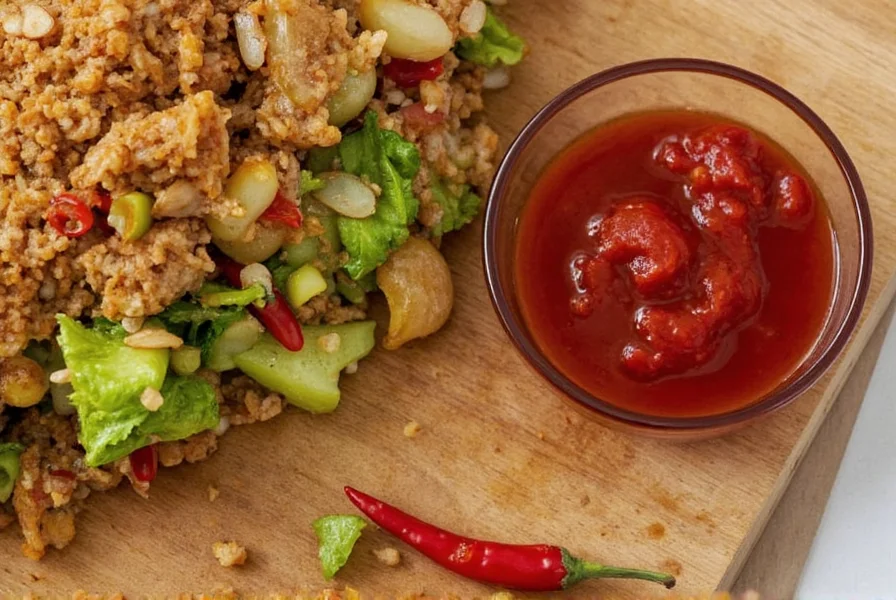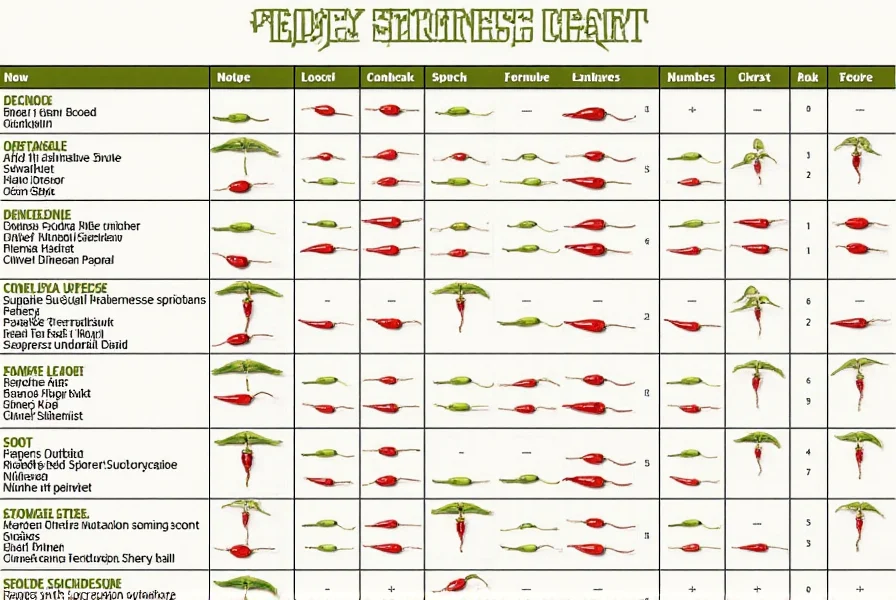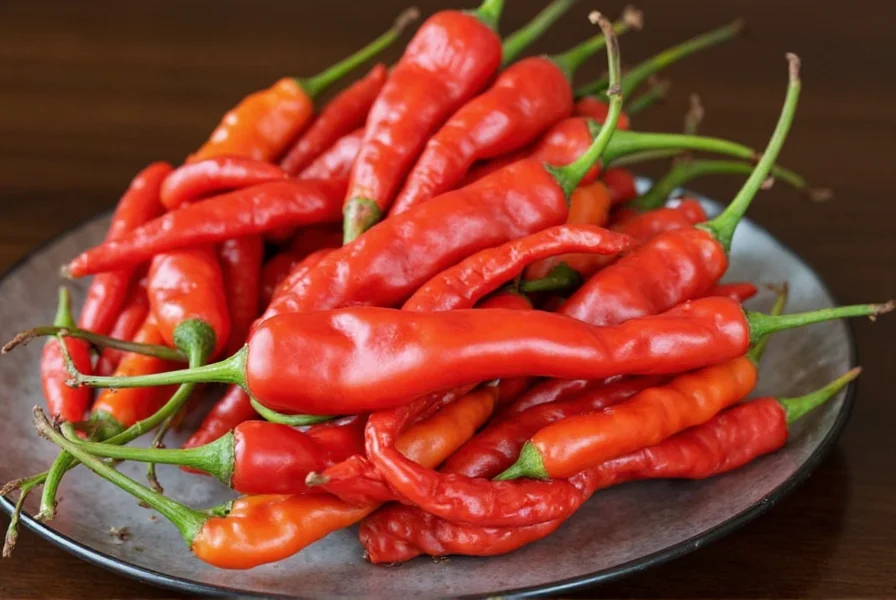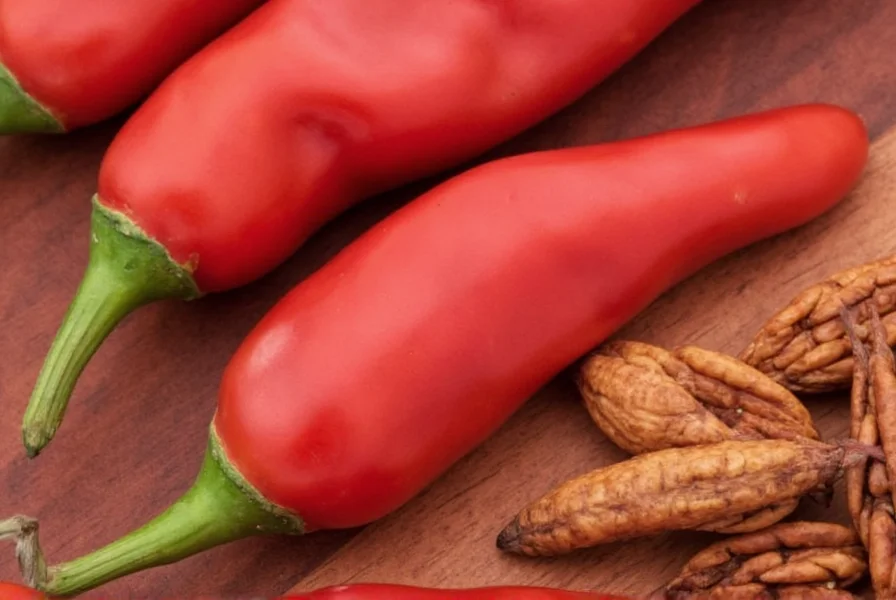Table of Contents
Introduction to Chile Serranos
Chile serranos (Capsicum annuum) are small, vibrant green peppers native to Mexico, known for their crisp texture and moderate heat ranging from 10,000 to 25,000 Scoville Heat Units (SHU). They're a staple in Mexican cuisine, essential for salsas, guacamole, and hot sauces. Whether you're a beginner or a seasoned cook, understanding chile serranos can elevate your dishes with bold flavor and controlled heat.

Unlike jalapeños, serranos offer a brighter, grassier flavor with consistent heat intensity. They're versatile for fresh applications like salsas or cooked dishes like stews, making them a kitchen essential for spice lovers.
Spice Levels and Heat Scale
| Pepper | Scoville Range |
|---|---|
| Jalapeño | 2,500–8,000 SHU |
| Chile Serrano | 10,000–25,000 SHU |
| Habanero | 100,000–350,000 SHU |
| Ghost Pepper | 1,000,000+ SHU |

The heat of chile serranos varies based on growing conditions, ripeness, and individual pepper characteristics. Green serranos (unripe) typically measure 10,000–20,000 SHU, while red ones (fully ripe) can reach up to 25,000 SHU. For context, serranos are 3–4 times hotter than jalapeños but significantly milder than habaneros. Always handle with care—capsaicin can cause skin irritation.
Cooking Uses and Flavor Profile
Chile serranos deliver a crisp texture, bright vegetal flavor, and sharp tang that enhances both raw and cooked dishes. Their versatility makes them ideal for:
- Salsa verde: Blend with tomatillos, garlic, and onion for a zesty green sauce (use 2–3 serranos per cup of tomatillos for medium heat).
- Guacamole: Finely chop 1 serrano per 3 avocados for a balanced kick without overpowering creaminess.
- Marinades: Puree with lime juice, cilantro, and olive oil for tenderizing meats like chicken or fish.
- Hot sauces: Ferment with vinegar and salt for a smoky, complex condiment that ages beautifully.
- Stir-fries: Slice thinly and add at the end for fresh heat in Asian-inspired dishes.

Pro tip: Roasting serranos before blending intensifies their flavor and reduces raw heat, perfect for smoky salsas or dips.
Buying Guide: How to Choose the Best Chile Serranos
Selecting fresh serranos requires attention to detail. Follow these expert tips:
- Firmness and skin: Look for peppers that are glossy, smooth, and firm to the touch—avoid any with soft spots, wrinkles, or discoloration.
- Color: Bright green indicates unripe peppers with sharper heat; deep red or yellow signifies ripeness and slightly sweeter notes.
- Size: Smaller peppers (1–2 inches) are typically hotter; larger ones may be milder but less intense.
- Smell: A fresh serrano has a clean, earthy aroma—skip any with moldy or sour odors.

For dried serranos, choose pods that are brittle, dark red, and free of moisture. They should have a strong, smoky scent and no signs of insect damage. Store dried peppers in airtight containers away from light to preserve potency.
Recommended Products
These trusted options suit different culinary needs:
- Organic Chile Serrano Peppers (Fresh): Ideal for salsas and fresh applications; certified organic and pesticide-free.
- Dried Chile Serrano Pods: Perfect for infusing heat into stews, soups, or spice blends; adds deep, smoky complexity.
- Chile Serrano Powder: A convenient seasoning for meats, soups, or rubs; blends evenly without altering texture.
Storage Tips for Fresh and Dried Chile Serranos
Proper storage extends freshness and preserves flavor:
- Fresh serranos: Place in a paper towel-lined container in the refrigerator; they stay crisp for 10–14 days. For longer storage, freeze chopped peppers in sealed bags for up to 6 months (thaw before using in cooked dishes).
- Dried serranos: Keep in an airtight glass jar in a cool, dark pantry; they retain potency for 12–18 months.
- Powder: Store in a sealed container away from humidity and light; use within 4–6 months for maximum flavor.

Always wash hands thoroughly after handling fresh peppers to avoid capsaicin transfer.
Frequently Asked Questions
How hot are chile serranos compared to jalapeños?
Chile serranos typically measure 10,000–25,000 Scoville Heat Units (SHU), while jalapeños range from 2,500–8,000 SHU. This means serranos are 3–4 times hotter than jalapeños. When substituting, use half the amount of serranos for similar heat intensity.
Can I substitute jalapeños for chile serranos in recipes?
Yes, but adjust quantities carefully. Jalapeños are milder, so use 1.5–2 times more jalapeños for equivalent heat. For flavor balance, add a pinch of cayenne or lime juice to compensate for serranos' brighter notes. Always taste as you go to avoid overpowering dishes.
What's the difference between green and red chile serranos?
Green serranos are unripe, with a sharper, grassier heat and higher acidity. Red serranos are fully ripe, offering sweeter, fruitier notes with slightly more intense heat (up to 25,000 SHU). Green are best for fresh salsas; red excel in cooked sauces or dried applications.
How do I handle chile serranos safely without burning my skin?
Always wear food-safe gloves when cutting or seeding serranos. Capsaicin can cause severe irritation if it contacts skin or eyes. After handling, wash hands with soap and cold water (hot water spreads capsaicin). Clean all surfaces and utensils immediately. Never touch your face during preparation.
How can I reduce the heat of chile serranos in my dishes?
Remove seeds and white membranes (placenta), which contain 80% of the capsaicin. Soak chopped serranos in salt water or milk for 15 minutes to neutralize heat. Cooking mellows intensity, and adding dairy (yogurt, sour cream) or acidic ingredients (lime juice) balances spiciness in finished dishes.
How do I know if a serrano pepper is ripe?
Ripe serranos turn from bright green to deep red or orange-yellow. They feel slightly softer than unripe peppers but remain firm. A ripe pepper has a sweeter aroma and smoother skin. For most culinary uses, green serranos are preferred for their sharp heat, while red ones add complexity to cooked dishes.
Can I eat chile serranos raw?
Yes, raw serranos are safe to eat and commonly used in salsas, guacamole, or as garnishes. Their crisp texture and vibrant flavor shine in fresh applications. Start with small amounts if you're new to spicy foods, and always wash thoroughly before consuming.
What are the health benefits of chile serranos?
Chile serranos are rich in vitamin C, antioxidants, and capsaicin, which may support metabolism, reduce inflammation, and boost immune function. However, they should be consumed in moderation. Consult a healthcare provider for personalized medical advice, especially if you have digestive sensitivities.
Easy Recipes with Chile Serranos
These simple recipes showcase serranos' versatility:
1. Salsa Verde
This vibrant green sauce is perfect for tacos, eggs, or chips. Makes 2 cups.
- Combine 1 cup roasted tomatillos, 2 fresh chile serranos (seeds removed), 1/4 diced red onion, 2 garlic cloves, and 1/4 cup cilantro in a blender.
- Add 1 tablespoon lime juice and salt to taste.
- Blend until smooth. Refrigerate for 1 hour before serving for best flavor.

2. Chile Serrano Guacamole
A creamy, spicy twist on classic guacamole. Serves 4.
- Mash 3 ripe avocados in a bowl.
- Add 1 finely diced serrano (seeds removed), 1/4 cup diced red onion, 1 tablespoon lime juice, and salt to taste.
- Stir gently. Serve immediately with tortilla chips or as a topping for grilled fish.

3. Stuffed Chile Serranos
Perfect for appetizers or light meals. Bakes in 30 minutes.
- Preheat oven to 375°F (190°C).
- Halve serranos lengthwise and remove seeds. Place on a baking sheet.
- Fill each half with a mixture of 1/2 cup cooked quinoa, 1/4 cup black beans, 1/4 cup shredded cheese, and spices.
- Bake for 25–30 minutes until peppers are tender and filling is golden.

Conclusion
Chile serranos are a kitchen essential for anyone seeking bold flavor with controlled heat. From salsas to stews, their versatility elevates everyday dishes while offering nutritional benefits. Remember to handle them safely, store properly, and experiment with heat levels to find your perfect balance. Whether you're a novice or a pro, mastering serranos unlocks endless culinary possibilities—start with these recipes and make every meal unforgettable.












 浙公网安备
33010002000092号
浙公网安备
33010002000092号 浙B2-20120091-4
浙B2-20120091-4